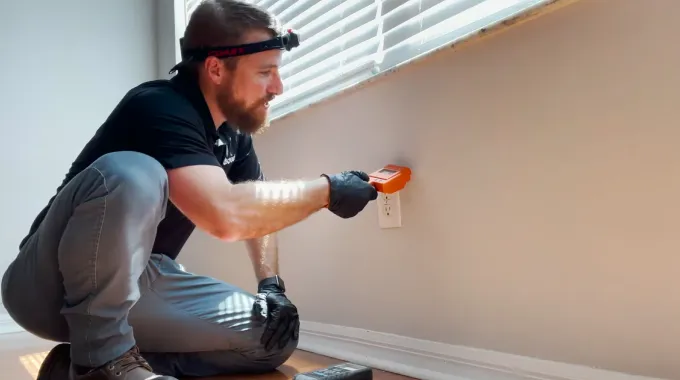Last Updated on August 2, 2023
Plaster walls get damaged by moisture, so homeowners must measure how much moisture is in the plaster. Moisture levels in plaster walls matter because too much can crack them. That’s why homeowners use moisture meters to detect dampness on plaster walls. But how do moisture meters work on plaster walls?
Moisture meters are a fantastic way to keep an eye on your plaster walls. With this simple tool, you’ll get an accurate reading that reveals what kind of humidity is going on inside your home plaster walls. This can be super important for preventing problems with structural integrity down the line.
This blog explains how these nifty handheld moisture meters work on plaster walls. We’ll break down the science behind it and tell you what readings to expect. Let’s dive in and discover more about mastering those tricky plaster walls with a moisture meter.
How Do Moisture Meters Work on Plaster Walls?

Moisture meters measure the conductivity of plaster walls through electrical resistance. This involves passing an electric current through the wall surface, which produces a voltage that the device can measure. The meter then converts this voltage into the moisture content of the wall.
The higher the moisture content, the more electricity can pass through the surface. Plaster walls are porous, meaning they are well suited for moisture meters as they allow for an easy flow of electricity.
Before you use a moisture meter on a plaster wall, ensure the surface is clean and dry. If there is dirt & dust on the surface, it could give an inaccurate reading.
How to Measure Moisture in Plaster Walls With a Moisture Meter?
Using a moisture meter, you can keep your home in top condition by ensuring that the walls are not too wet or too dry. The following is a step-by-step guide on how to measure moisture in plaster walls with a moisture meter:
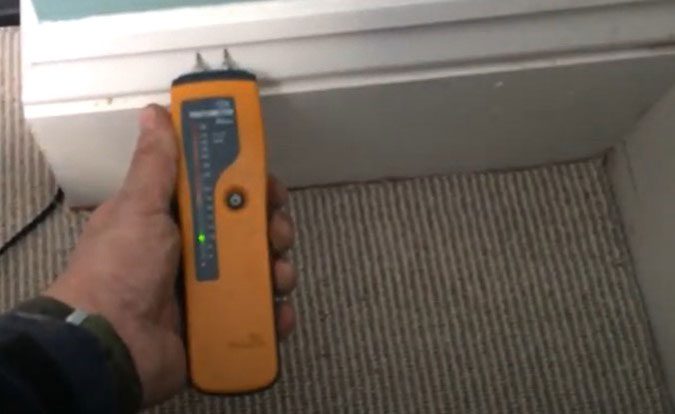
Step 1: Purchase the correct type of moisture meter (pin-type moisture tester with LCD) for detecting moisture in plaster walls. Make sure to buy one that reads for plaster walls and is designed for long-term use. Avoid purchasing cheap models, as they tend to be inaccurate.
Step 2: Before you test the plaster wall for moisture, clean it. Remove any dirt, dust, or debris with a vacuum cleaner or brush attachment. This will make sure that the readings are accurate. If there is any dirt or debris, it could make the results not accurate.
Step 3: Insert two pins into the wall at different points on each side where you intend to measure the moisture content level. This ensures an accurate reading of the tested area since other factors, such as humidity levels, could affect it otherwise.
Step 4: Turn on the device and take a reading at each point by pressing it against both pins. When you do this, you should get two different readings from each pin (for example, 8% and 12%).
The average between these two numbers is then taken to show the moisture content level in your plaster wall at that particular time.
Step 5: If the reading is above 15%, we need to investigate more. We might need to replace parts of the house or add waterproofing material to the outside surfaces.
If the reading is below 15%, everything is okay, and no further action is needed. But you should still measure things to make sure that there are no issues in the future.
How Do I Know If There is Moisture in Plaster Walls?
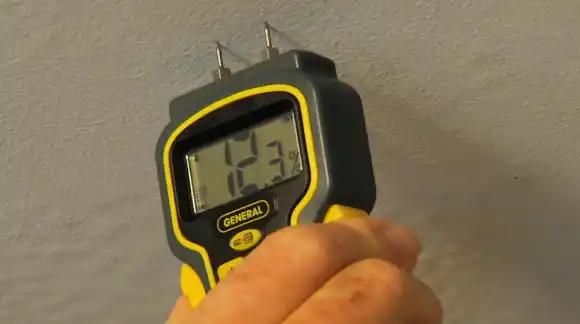
You can look for some things to see if your walls have a moisture problem. These include the condition of your plaster walls.
Peeling Paint
If you notice that your paint is peeling away from the plaster wall, this could signify that there is excessive moisture within the plaster. This is because too much moisture in the air or in the wall itself can cause paint to bubble and flake off.
You should also look for any signs of bubbling or blistering on the paint surface. This would state that there is too much moisture present.
Yellowish Discoloration
If you notice that your plaster walls have a yellowish tint, this is a sign that they have a high moisture content. This usually happens when the wall has been wet or damp for a long time.
It causes mildew and mold to grow on the surface over time. If you smell something terrible, it could mean water damage.
Warping or Buckling Surfaces
Warping or buckling surfaces are common signs of excess moisture in plaster walls. When water builds up in a wall, it can make the wood expand outward. This makes big sections of the wall look like they are rippling.
If you see cracks in the corners of your walls or around moldings, this could signify that there has been prolonged exposure to high humidity levels. This can cause more damage, so you may need to get it repaired by a professional before more problems occur.
By looking at these visual signs, you can help to identify if water is present in the plaster walls. If you see these signs, get professional help before more damage.
What are Normal Moisture Levels in Plaster Walls?
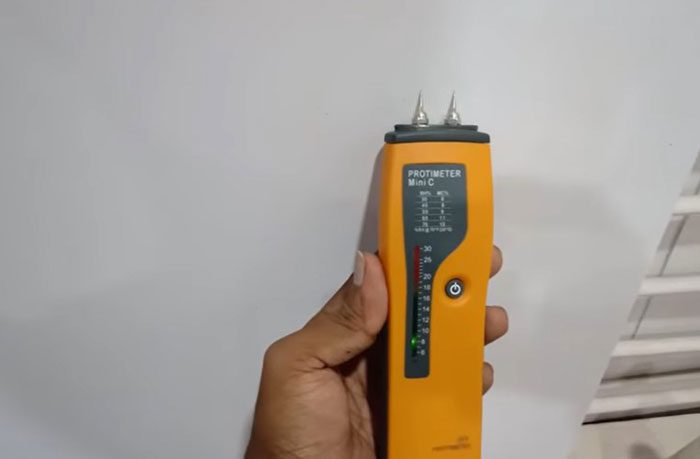
Normal moisture percentages in plaster walls are between 12-15%. This range is determined by the relative humidity of the outside air and the amount of time the wall has been exposed to water.
Plaster walls can protect us from the elements, but they’re prone to swelling if exposed to moisture. Bulging or cracking can compromise their integrity and let water seep through, potentially leading to further damage.
When Should You Measure a Home Plaster Walls With a Moisture Meter?
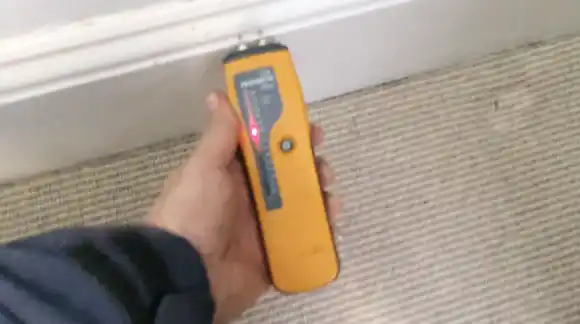
Before deciding about home improvement projects or buying a house, use a moisture meter to check the plaster walls for moisture. Doing this will help protect your investment in the home and reduce future problems with too much moisture:
A. Flooded Homes
When a home has been flooded, you should always use a moisture meter to measure how much water has gotten into the walls. This is important because too much moisture in walls can create a place for mold and mildew to grow.
It is hard to tell when bugs have infested your home. To figure it out, you need to use extra tools, like a moisture meter. This device helps determine how much water has been absorbed into the plaster walls. With this information, you can decide what needs to be done to fix the damage properly.
B. Before Buying a House
When looking at homes to buy, you must measure the amount of moisture in the walls with a reliable tool. This will help them to see any mold or mildew early on. That way, they can look for solutions before they sign the contract.
Also, measuring the walls’ moisture content can give you an idea of whether there are any problems with water infiltration from outside sources. This way, you can address any issues before they become a bigger problem.
If you do this step, it will help people who want to buy your home. They will know if they need to fix anything before they buy it. This saves them time and money in the long run.
C. Before Installing Wood
Before you put the wood onto a plaster wall, you should check how wet the wall is using a moisture meter. This will help you feel better and ensure the wood is not ruined.
In this way, people can see if there is too much water. It might make the wood parts of the house warp, split, or change color over time. If this happens and is not fixed, it will cost more later.
Taking the step to maintain your wood furniture today can reap long-term rewards. Keep it in excellent condition for years, save money, and spare yourself from costly repairs.
D. After Plastering over Cement Board
It’s essential to measure moisture content after plastering over cement board. Since the cement board is not entirely waterproof, ensuring the plaster is not holding too much moisture is crucial. Failure to do so can lead to problems such as the development of mold and mildew, which can be costly to remediate.
Can You Use a Wood Moisture Meter on Plaster Walls?
Yes, you can use a wood moisture gauge on plaster walls. Moisture meters measure the amount of water in the tested material and are suitable for most building materials, including wood and plaster.
Read the manufacturer’s instructions before measuring the moisture in plaster walls. This is because different meters have different settings and abilities.
How Reliable are Moisture Meters on Plaster Walls?
Moisture meters can be highly reliable when used on plaster walls, but you must invest in a high-quality device for accurate readings. Low-quality or outdated devices might not give accurate readings, so you should get a plaster wall moisture meter.
If the readings you’re getting seem way off from what you’d expect in your home environment, don’t act too. It’s worthwhile to run a quick check or calibration on your device before anything else. That could save lots of trouble down the road.
Can Moisture Meters Give False Readings on Plaster Walls?
Moisture meters can give false readings when used on plaster walls. This can occur if the meter is faulty or an issue with the calibration.
Also, inaccuracies can arise if the wall needs to be adequately prepared before testing. To ensure accurate readings, a premium-quality moisture meter must be calibrated and tested against a known standard.
Are Cheap Moisture Meters Any Good on Plaster Walls?
Cheap moisture meters are generally not suitable for use on plaster walls. Because they tend to provide inaccurate and unreliable results. Getting a high-quality moisture meter from a reputable brand is a good idea.
This will help you get accurate readings when measuring moisture levels in plaster walls. Quality models are usually more expensive than cheap ones. But they provide more reliable readings and are more durable over time.
Tackle Plaster Wall Moisture Issues with a Moisture Meter
Moisture meters are a great way to measure the moisture level in your plaster walls. Make sure you know acceptable levels and when to use a meter. It’ll keep your house safe by preventing moisture from getting into the structure.
Even though cheaper moisture meters may not be as accurate as more expensive models, they can still give you some helpful information. This can help keep your home from getting more damage from too much moisture.
Remember that following the manufacturer’s instructions is essential for safe and effective use. Don’t forget to ensure your space hasn’t been affected by water damage before pulling out your wallet.
